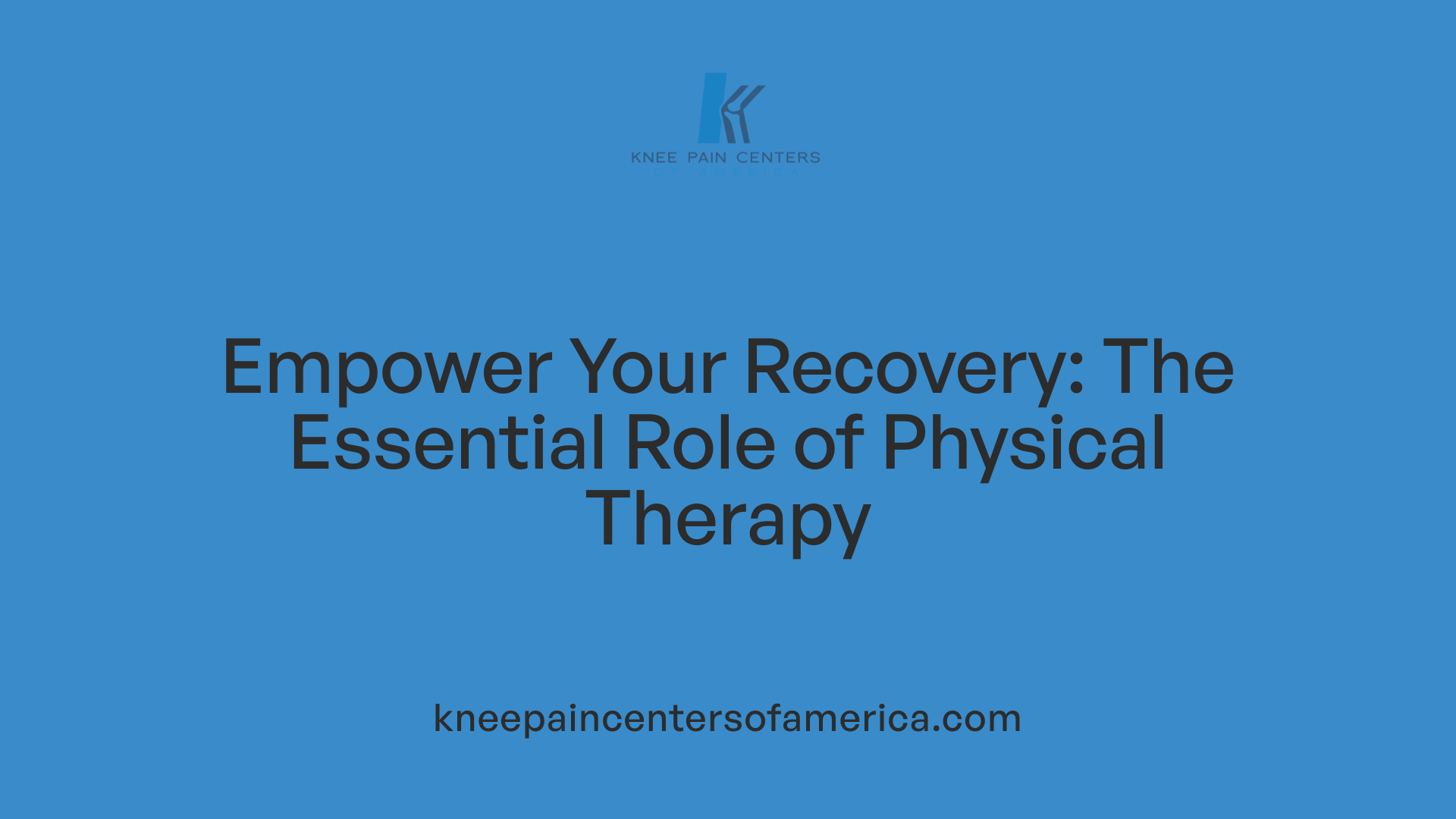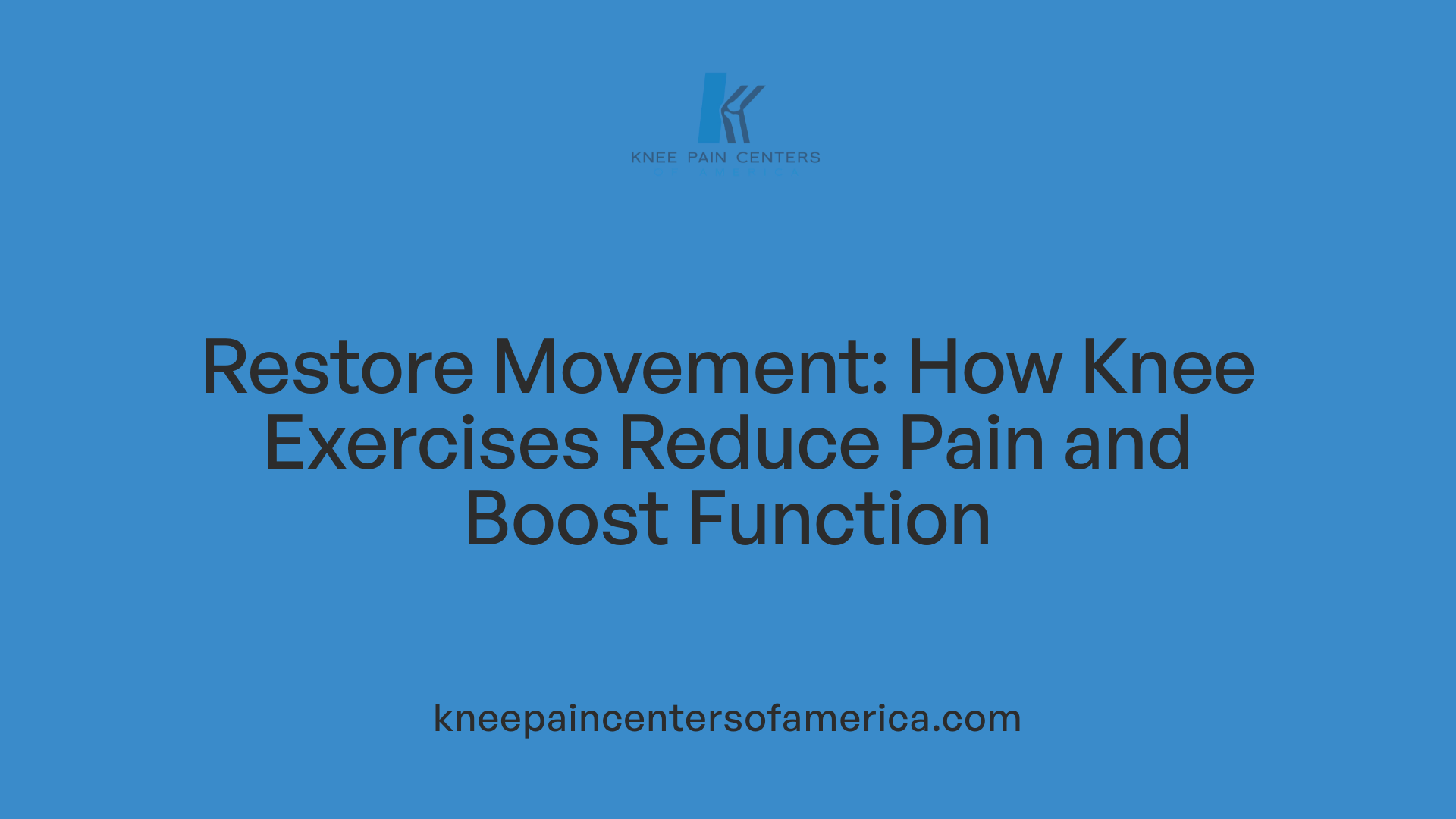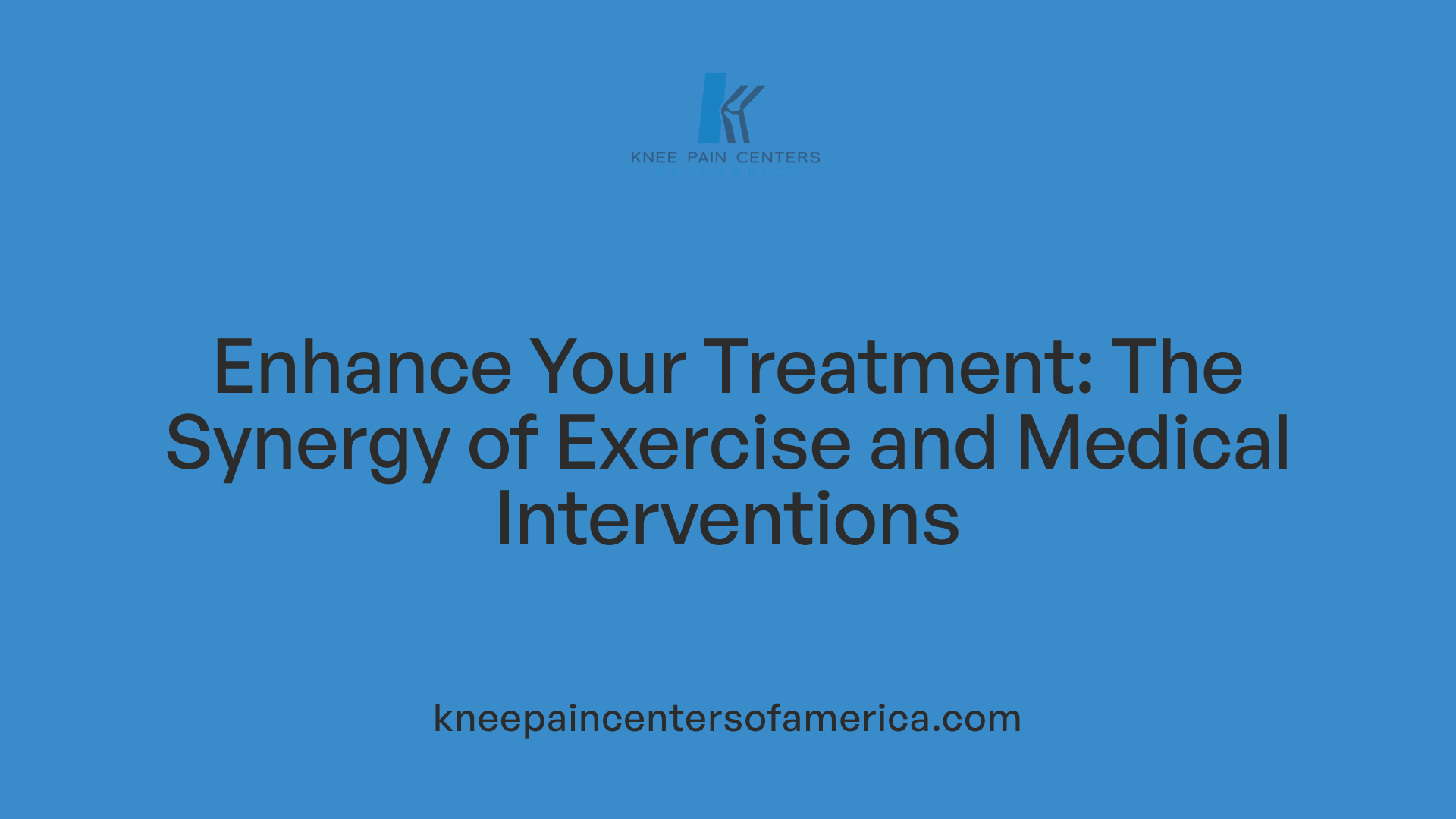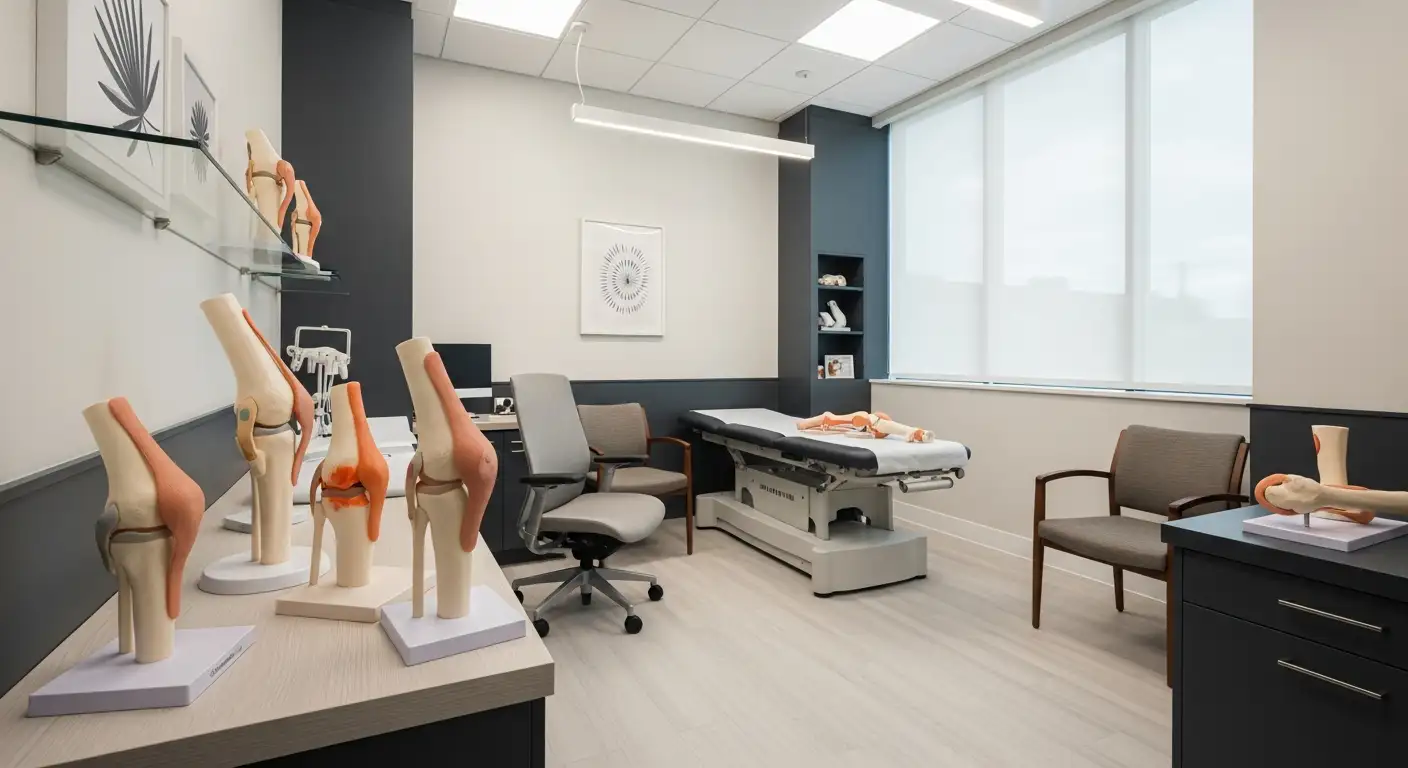Why Knee Mobility Matters in Pain Management
Knee pain, particularly due to osteoarthritis (OA), affects millions worldwide, diminishing quality of life through stiffness, reduced flexibility, and discomfort. While medical interventions offer various paths to relief, the role of knee mobility exercises stands out as an essential, non-invasive strategy. This article explores how these targeted exercises contribute to pain relief, support joint health, and complement broader treatment approaches for knee osteoarthritis.
Understanding Knee Osteoarthritis and Conventional Treatments
What are the common medical treatments available for knee pain and osteoarthritis?
Management of knee osteoarthritis (OA) typically begins with conservative treatments aimed at reducing pain and improving function. Physical therapy plays a crucial role, focusing on strengthening muscles—especially the quadriceps—to stabilize the knee. Low-impact exercises like swimming and walking are encouraged to improve cardiovascular health and maintain joint mobility without excessive joint stress.
Weight management is also important to reduce load on the knee joints. Assistive devices such as braces and canes may be used to support joint function. Medications form an additional pillar of treatment. Over-the-counter acetaminophen and nonsteroidal anti-inflammatory drugs (NSAIDs) help alleviate pain and inflammation. When symptoms persist, topical creams, corticosteroid injections, or hyaluronic acid injections may be employed to provide targeted relief.
If these non-surgical approaches are inadequate, surgical options become considerations. Procedures such as knee osteotomy, debridement, or total knee replacement aim to restore joint function and alleviate symptoms. Treatment plans are individualized to match patient needs, often combining lifestyle changes, medications, and possibly surgery for optimal management.
When is knee replacement surgery considered for osteoarthritis patients?
Knee replacement surgery is generally reserved for patients with advanced knee OA who have not achieved sufficient relief from conservative treatments. When pain and joint damage severely disrupt daily activities and quality of life, surgery becomes a viable option.
Factors influencing the decision include the severity of joint degeneration, patient age, activity level, and overall health status. Older individuals are more likely candidates given the longevity of prosthetic implants and surgical risks.
Although knee replacement is major surgery with inherent risks, it offers effective symptom relief, with long-term satisfaction reported by around 80% of patients. Ultimately, the timing and appropriateness of surgery are tailored to each person’s condition and response to prior therapies.
The Role of Physical Therapy and Exercise in Knee OA Management

What role does physical therapy play in treating knee osteoarthritis?
Physical therapy is fundamental in managing knee osteoarthritis (KOA), primarily through strengthening the muscles around the knee joint. This support helps stabilize the joint, significantly reducing pain and slowing disease progression. Therapists often prescribe range-of-motion exercises that improve joint flexibility and reduce stiffness. Manual therapies can enhance mobility further, while additional recommendations may include bracing to offload stress, weight management, and activity modifications.
How do range of motion and strengthening exercises benefit knee OA?
Range-of-motion exercises such as gentle stretching should be performed daily to maintain and improve joint flexibility. Strengthening exercises, particularly targeting the quadriceps and surrounding muscles, help support and protect the knee joint. Exercises like straight leg raises, sit-to-stand movements, half squats, and hamstring stretches improve muscle strength and joint stability. These exercises alleviate pain, improve mobility, and enhance overall knee function, allowing for a greater range of daily activities.
What exercise modalities are effective for knee osteoarthritis?
Several exercise modalities have therapeutic effects for KOA:
- Aerobic exercises (walking, swimming, biking) improve cardiovascular health, help weight management, and reduce joint stress.
- Strength training enhances muscle strength, especially in the quadriceps, linked to pain reduction.
- Neuromuscular and balance training improve joint stability and reduce falls.
- Aquatic exercises lower joint pressure and are ideal for obese patients due to reduced load.
- Traditional exercises such as Tai Chi and Yoga improve pain, balance, muscle strength, and mental well-being.
Overall, physical therapy combined with a variety of tailored exercises forms the cornerstone of conservative KOA treatment, effectively relieving pain and improving function without invasive procedures.
How Knee Mobility Exercises Alleviate Pain and Improve Function

Mechanisms of pain reduction through exercise
Exercise training helps reduce knee pain in osteoarthritis (OA) by engaging both peripheral and central pathways. Mechanical activities like dynamic compression and cyclic tensile strain during knee movements can inhibit inflammation within the joint. Furthermore, exercise counteracts inflammatory mediators such as cytokines (e.g., IL-1β, IL-6, TNF-α) and prostaglandins, lowering peripheral sensitization. On the central level, physical activity reduces nervous system excitability and raises pain thresholds, which decreases chronic pain sensations.
Impact on inflammation and cartilage health
Knee mobility exercises influence biochemical markers related to inflammation and cartilage degradation. They regulate signaling pathways and reduce levels of matrix metalloproteinases (like MMP-13), molecules that typically promote cartilage breakdown. Regular exercise also prevents cartilage degeneration and subchondral bone loss, helping maintain joint integrity. Animal studies demonstrate exercise's role in reducing joint inflammation and improving tendon structures, delaying musculoskeletal atrophy.
Stabilization and muscle strengthening benefits
Strengthening exercises, especially targeting the quadriceps femoris, improve muscle cross-sectional area and support joint stabilization. This muscular support lessens knee joint loads during movement, contributing to pain relief and slowing disease progression. Balance and proprioception training further enhance joint stability and reduce fall risk. Common effective exercises include straight leg raises, hamstring curls, wall slides, and step-ups, which restore knee function, flexibility, and muscle strength.
Integrating these knee mobility exercises under professional guidance can significantly alleviate pain, improve function, and support long-term joint health in individuals with knee osteoarthritis.
Diverse Exercise Modalities Beneficial for Knee Osteoarthritis

Aerobic, Strength, Neuromuscular, and Balance Exercises
Various exercise types can effectively manage knee osteoarthritis (KOA) symptoms. Aerobic exercises like walking, jogging, swimming, and biking improve cardiovascular health, reduce fatigue, and aid in weight management, indirectly relieving joint stress. Strength training, particularly focusing on the quadriceps, enhances muscle strength, which supports joint stability and helps reduce pain. Neuromuscular exercises work to improve joint stability and reduce knee joint loads, proving beneficial even for older adults with KOA. Balance and proprioception training also play important roles, lowering the risk of falls, improving joint control, and easing symptoms.
Aquatic and Traditional Exercises Like Tai Chi and Yoga
Aquatic exercises performed in shoulder-height water reduce joint loading and provide resistance that helps relieve pain and improve function for those with hip and knee osteoarthritis. These exercises are especially suitable for obese patients given the decreased joint pressure in water. Traditional exercise forms such as Ba Duanjin, Tai Chi, Wuqinxi, and Yoga offer multidimensional benefits including pain relief, improved muscle strength and balance, mental health support, and regulation of inflammation. These gentle, low-impact exercises are highly suitable for elderly patients and can be easily incorporated into daily routines.
Specific Exercises Supporting Knee Mobility
Targeted exercises for knee health include walking and range of motion activities like gentle stretching daily to maintain joint flexibility. Strengthening exercises such as straight-leg raises, side leg raises, sit-to-stand movements, half squats, hamstring stretches, knee flexion and extension, step-ups, and heel raises help restore normal knee function and strengthen the muscles around the joint. These exercises not only improve mobility but also support joint stabilization, reduce pain, and delay disease progression. Combining these modalities under healthcare provider guidance optimizes outcome for individuals with KOA.
Safety and Personalized Exercise Plans in Managing Knee OA

Avoiding impact activities
For individuals with knee osteoarthritis (KOA), it is crucial to avoid high-impact exercises that may exacerbate joint pain or damage. Activities causing increased discomfort should be skipped to prevent further aggravation of the knee. Instead, low-impact exercises such as aquatic workouts, walking, and gentle stretching are recommended to maintain joint mobility without placing undue stress on the knee.
Tailoring exercise programs according to individual needs
Since KOA severity and symptoms vary among patients, exercise regimens should be thoughtfully tailored. Incorporating a mix of strengthening, aerobic, and flexibility exercises adjusted to an individual's capabilities can optimize benefits. Strengthening muscles around the knee, including quadriceps and hamstrings, supports joint stability and reduces pain. Patients are encouraged to try different exercise types under supervision to find the most effective and comfortable routine.
Importance of healthcare consultation
Consulting healthcare professionals is essential before beginning any exercise program. Medical providers can assess the patient's condition, recommend appropriate exercises, and help set realistic goals. Personalized plans designed with medical guidance enhance safety, efficacy, and adherence. Regular monitoring ensures that exercises remain suitable and adjustments are made as needed for optimal knee health and symptom management.
Complementing Exercise with Medical and Minimally Invasive Treatments

How do corticosteroid injections help in managing knee osteoarthritis?
Corticosteroid injections are used to reduce inflammation and relieve pain in knee osteoarthritis. These injections deliver medication directly into the knee joint, calming the immune response and decreasing swelling. Patients often experience temporary relief from symptoms such as stiffness and limited movement. However, the effects typically last only from weeks to a few months.
Repeated corticosteroid injections carry risks, including potential joint damage and cartilage deterioration. Evidence suggests that corticosteroids may impair cartilage repair, which could contribute to increased joint damage over time. Due to these risks, corticosteroid injections should be used cautiously and usually reserved for short-term symptom management. Alternative treatments like hyaluronic acid injections may offer symptom relief with fewer potential harms.
Are there any minimally invasive surgical options for treating knee osteoarthritis?
Several minimally invasive surgical procedures exist to treat knee osteoarthritis. Arthroscopy is one such option that uses small incisions to clean out the joint, removing debris or damaged tissue.
Minimally invasive total knee replacement involves smaller incisions and less tissue disruption, resulting in faster recovery. Other newer outpatient treatments include genicular artery embolization (GAE), which reduces blood flow to inflamed areas, and genicular nerve ablation (GNA), which targets nerve signals to decrease pain.
These minimally invasive options generally have shorter recovery times and fewer complications than traditional surgery. They provide symptom relief and improved knee function, especially for patients not suited for more invasive procedures.
Integrating exercise into comprehensive treatment plans
While corticosteroid injections and minimally invasive surgeries address pain and inflammation, exercise remains a vital component of managing knee osteoarthritis. Regular exercise improves pain, joint function, muscle strength, and inflammation control. It complements medical treatments by addressing the underlying biomechanical and inflammatory aspects of the condition.
Healthcare providers often recommend personalized exercise programs alongside medical interventions to optimize outcomes. Combining therapeutic exercise with cautious use of injections or minimally invasive procedures offers a balanced approach for relieving symptoms and maintaining knee health.
Integrating Knee Mobility Exercises into Holistic Pain Relief Strategies
Knee mobility exercises are a cornerstone for managing pain and enhancing function in osteoarthritis patients. Their ability to improve muscle strength, joint flexibility, and reduce inflammation contributes significantly to symptom alleviation. When combined with physical therapy guidance, safe exercise practices, and appropriate medical treatments—including medications and minimally invasive procedures—patients achieve more sustainable outcomes. Personalized exercise regimens, supported by healthcare professionals, empower individuals to take active roles in their recovery and potentially delay or avoid more invasive interventions. Ultimately, incorporating these exercises into daily routines is vital for maintaining knee health and improving quality of life in those affected by knee osteoarthritis.
References
- Benefits and Mechanisms of Exercise Training for Knee ...
- Benefits of Exercise for Osteoarthritis
- Knee Strengthening Exercises for Osteoarthritis
- The pain-relieving qualities of exercise in knee osteoarthritis
- 6 Exercises to Help Your Knee Pain
- Knee Injections for Pain Relief
- Cortisone Shots (Steroid Injections): Benefits & Side Effects





